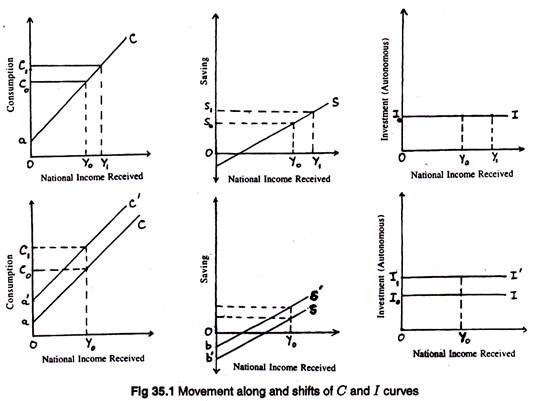Learn about the comparison between Movements along Curves vs. Shifts of Curves.
Movement Along Curves:
The distinction between movement along curve and shift of curve is illustrated in Fig. 35.1. When national income is Y0 aggregate consumption is C0 and saving is S0. Moreover, the investment that takes place at this level of income is I0. Suppose now national income rises from Y0 to Y1. In part (i) of Fig. 35.1 we may now show the effect of an increase in income from Y0 to Y1.
Now consumption spending rises from C0 to C1. Saving also rises from S0 to S1. These responses are measured by marginal propensities to consume and save, respectively. But investment remains unchanged at the original level I0. Such changes in consumption and saving represent the responses to a change in income.
Shifts of Curves:
If the curves shift we observe that a new level of expenditure is associated with each level of national income. We illustrate such shifts in part (ii) of Fig. 35.1. Here the consumption curve shifts from C to C’ due to, say, an increase in society’s stock of wealth.
ADVERTISEMENTS:
This may make households less interested in saving more. An upward shift of the consumption curve implies a downward shift of the saving curve—from S to S’. This means that less is saved as each level of income, presumably for the same reason that more is spent on consumption.
The shift of the autonomous investment curve form I to I’ shows an increase in investment spending. This means that more is spent on investment at each level of income, say, due to a marginal fall in the rate of interest or an improvement in profit prospect (due to an increase in marginal efficiency of capital).
These examples enable us to make a general statement: a shift in any function relating planned (desired) expenditure to national income [such as C = ƒ(Y) or S = ƒ(Y)] indicates that the level of expenditure associated with each level of income has changed. We may now examine the effects of such shifts in expenditure functions on the equilibrium level of national income.
